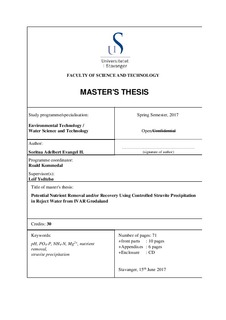| dc.description.abstract | The main focus of this study was to investigate the possibilities to control struvite precipitation in IVAR Grødaland, Norway, by determining the optimum conditions for struvite to precipitate. A laboratory scale experiment was conducted using jar testing method. Artificial wastewater and reject water from IVAR Grødaland were used in the test, with similar leves of phosphate and ammonia and variable dosages of magnesium. Struvite precipitation is a pH dependent reaction, and the experiments started with determining the optimum pH by comparing 4 different pH levels from 8 to 11. The result showed that at pH 10, PO4-P, Mg2+, and NH4-N removal were 5.4 moles, 5.1 moles and 5.2 moles respectively, and 728 mg/l or 5.3 moles TSS assumed to be struvite was formed in the artificial wastewater. In reject water, PO4-P, Mg2+, and NH4-N were removed 3.9 moles, 2.9 moles and 18.1 moles respectively and 508 mg/l or 3.7 moles TSS assumed to be struvite produced. Using pH 10 as optimum condition, determining optimum Mg2+ dosage was conducted using 4 different PO4-P: Mg2+ molar ratios. In artificial wastewater PO4-P: Mg2+ molar ratios were 1:1; 1:2; 1:3; and 1:4. With PO4-P completely removed and the amount of Mg2+ added were low, the optimum dosage was determined to 1:2 PO4-P: Mg2+ molar ratios. Increased Mg2+ dosage would increase the TSS but resulting other crystal an addition to struvite. Tests on reject water continued at smaller ranges of Mg2+ dosage with PO4-P: Mg2+ molar ratios, which were 1:1; 1:1.5; 1:2; and 1:2.5. The optimum dosage was 1:1.5 PO4-P: Mg2+ molar ratio with PO4-P completely removed and Mg2+ had 60% average removal. Tests with increasing the mixing time to 10 minutes rapid mixing and 20 minutes slow mixing showed no significant improvement. By changing the Mg2+ source into sea water, the best dosage was 10% volume of sea water addition with PO4-P completely removed and Mg2+ average removal efficiency at 68% in reject water and 98.2% removal efficiency in artificial wastewater. The tests showed that struvite precipitation can be control at pH 10 and addition of Mg2+ between 1 – 1,5 moles that depend on the reject water characteristics. The overall results show that efficient struvite precipitation on reject water is feasible and that seawater appears as a realistic Mg source | nb_NO |
